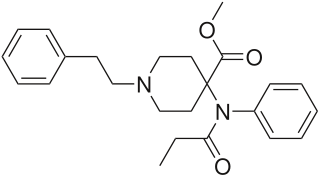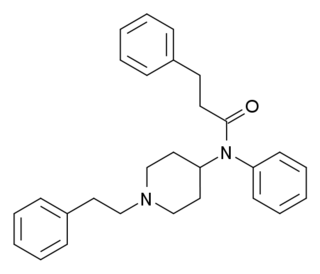
Heroin, also known as diacetylmorphine and diamorphine among other names, is a morphinan opioid substance synthesized from the dried latex of the opium poppy; it is mainly used as a recreational drug for its euphoric effects. Heroin is used medically in several countries to relieve pain, such as during childbirth or a heart attack, as well as in opioid replacement therapy. Medical-grade diamorphine is used as a pure hydrochloride salt. Various white and brown powders sold illegally around the world as heroin are routinely diluted with cutting agents. Black tar heroin is a variable admixture of morphine derivatives—predominantly 6-MAM (6-monoacetylmorphine), which is the result of crude acetylation during clandestine production of street heroin.

Fentanyl is a highly potent synthetic piperidine opioid primarily used as an analgesic. It is 20 to 40 times more potent than heroin and 100 times more potent than morphine; its primary clinical utility is in pain management for cancer patients and those recovering from painful surgeries. Fentanyl is also used as a sedative. Depending on the method of delivery, fentanyl can be very fast acting and ingesting a relatively small quantity can cause overdose. Fentanyl works by activating μ-opioid receptors. Fentanyl is sold under the brand names Actiq, Duragesic and Sublimaze, among others.

Carfentanil or carfentanyl, sold under the brand name Wildnil, is an extremely potent opioid analgesic used in veterinary medicine to anesthetize large animals such as elephants and rhinoceroses. It is typically administered in this context by tranquilizer dart. Carfentanil has also been used in humans to image opioid receptors. It has additionally been used as a recreational drug, typically by injection, insufflation, or inhalation. Deaths have been reported in association with carfentanil.

Viminol is an opioid analgesic developed by a team at the drug company Zambon in the 1960s. Viminol is based on the α-pyrryl-2-aminoethanol structure, unlike any other class of opioids.

AH-7921 (Doxylam) is an opioid analgesic drug selective for the μ-opioid receptor, having around 90% the potency of morphine when administered orally. It was discovered in the 1970s by a team at Allen and Hanburys located in the United Kingdom. The drug is considered a new psychoactive substance (NPS) in which it is synthetically created in laboratories to mimic that of controlled substances. The substance has also been sold on the internet since 2012 as a "research chemical". When sold online it may be called the alternative name doxylam, not to be confused with doxylamine. AH-7921 has never progressed to clinical trials. The DEA is not aware of any medical usage in the United States, and has not insisted the Health and Human Services department (HHS) to conduct any medical research of the substance's uses.

Butyrfentanyl or butyrylfentanyl is a potent short-acting synthetic opioid analgesic drug. It is an analog of fentanyl with around one quarter of its potency. One of the first mentions of this drug can be found in document written by The College on Problem of Drug Dependence, where it is mentioned as N-butyramide fentanyl analog. This document also states that the article describing its clinical effects was published in 1987. It is an agonist for the μ-opioid receptors.

U-47700, also known as U4, pink heroin, pinky, and pink, is an opioid analgesic drug developed by a team at Upjohn in the 1970s which has around 7.5 times the potency of morphine in animal models.

Acetylfentanyl is an opioid analgesic drug that is an analog of fentanyl. Studies have estimated acetylfentanyl to be 15 times more potent than morphine, which would mean that despite being somewhat weaker than fentanyl, it is nevertheless still several times stronger than pure heroin. It has never been licensed for medical use and instead has only been sold on the illicit drug market. Acetylfentanyl was discovered at the same time as fentanyl itself and had only rarely been encountered on the illicit market in the late 1980s. However, in 2013, Canadian police seized 3 kilograms of acetylfentanyl. As a μ-opioid receptor agonist, acetylfentanyl may serve as a direct substitute for oxycodone, heroin or other opioids. Common side effects of fentanyl analogs are similar to those of fentanyl itself, which include itching, nausea and potentially fatal respiratory depression. Fentanyl analogs have killed hundreds of people throughout Europe and the former Soviet republics since the most recent resurgence in use began in Estonia in the early 2000s, and novel derivatives continue to appear.

Furanylfentanyl (Fu-F) is an opioid analgesic that is an analog of fentanyl and has been sold as a designer drug. It has an ED50 value of 0.02 mg/kg in mice. This makes it approximately one fifth as potent as fentanyl.

4-Fluorobutyrylfentanyl (also known as 4-FBF and p-FBF or para-fluorobutyrylfentanyl) is an opioid analgesic that is an analog of butyrfentanyl and has been sold online as a designer drug. It is closely related to 4-fluorofentanyl, which has an EC50 value of 4.2 nM for the human μ-opioid receptor.

Acrylfentanyl (also known as acryloylfentanyl) is a highly potent opioid analgesic that is an analog of fentanyl and has been sold online as a designer drug. In animal studies the IC50 (the half maximal inhibitory concentration for acrylfentanyl to displace naloxone) is 1.4 nM, being slightly more potent than fentanyl itself (1.6 nM) as well as having a longer duration of action.

There is an ongoing opioid epidemic in the United States, originating out of both medical prescriptions and illegal sources. It has been called "one of the most devastating public health catastrophes of our time". The opioid epidemic unfolded in three waves. The first wave of the epidemic in the United States began in the late 1990s, according to the Centers for Disease Control and Prevention (CDC), when opioids were increasingly prescribed for pain management, resulting in a rise in overall opioid use throughout subsequent years. The second wave was from an expansion in the heroin market to supply already addicted people. The third wave starting in 2013 was marked by a steep 1,040% increase in the synthetic opioid-involved death rate as synthetic opioids flooded the US market.

Cyclopropylfentanyl is an opioid analgesic that is an analog of fentanyl and has been sold as a designer drug. Between June and December 2017, a total of 78 cyclopropylfentanyl-related deaths with analytical confirmation in post-mortem samples were reported by various European countries. Another 115 deaths involving cyclopropylfentanyl were reported from the United States in 2017.

Benzoylfentanyl, also known as phenylfentanyl, is an opioid analgesic that is an analog of fentanyl and has been sold as a designer drug. In the United States, benzoylfentanyl was first identified in Drug Enforcement Administration drug seizures in 2018.

Tetramethylcyclopropylfentanyl is an opioid analgesic that is an analog of fentanyl and has been sold as a designer drug.

Benzodioxolefentanyl is an opioid analgesic that is an analog of fentanyl and has been sold as a designer drug.

3-Phenylpropanoylfentanyl (β'-phenylfentanyl) is an opioid analgesic that is an analog of fentanyl, which was invented in 1981, and has been sold as a designer drug, first identified in March 2017 in Sweden.

The opioid epidemic, also referred to as the opioid crisis, is the rapid increase in the overuse, misuse/abuse, and overdose deaths attributed either in part or in whole to the class of drugs called opiates/opioids since the 1990s. It includes the significant medical, social, psychological, demographic and economic consequences of the medical, non-medical, and recreational abuse of these medications.

2F-QMPSB (SGT-13) is an arylsulfonamide-based synthetic cannabinoid that is a fluorinated derivative of QMPSB and has been sold as a designer drug. Its identification was first reported by a forensic laboratory in Italy in January 2019, and it was made illegal in Latvia shortly afterwards. Fluorination of the tail group is a common strategy to increase potency at cannabinoid receptors which is seen in many related series of compounds.

Acetoxymethylketobemidone (O-AMKD), is an opioid designer drug related to ketobemidone, with around the same potency as morphine. It was first identified in Germany in October 2020.




















